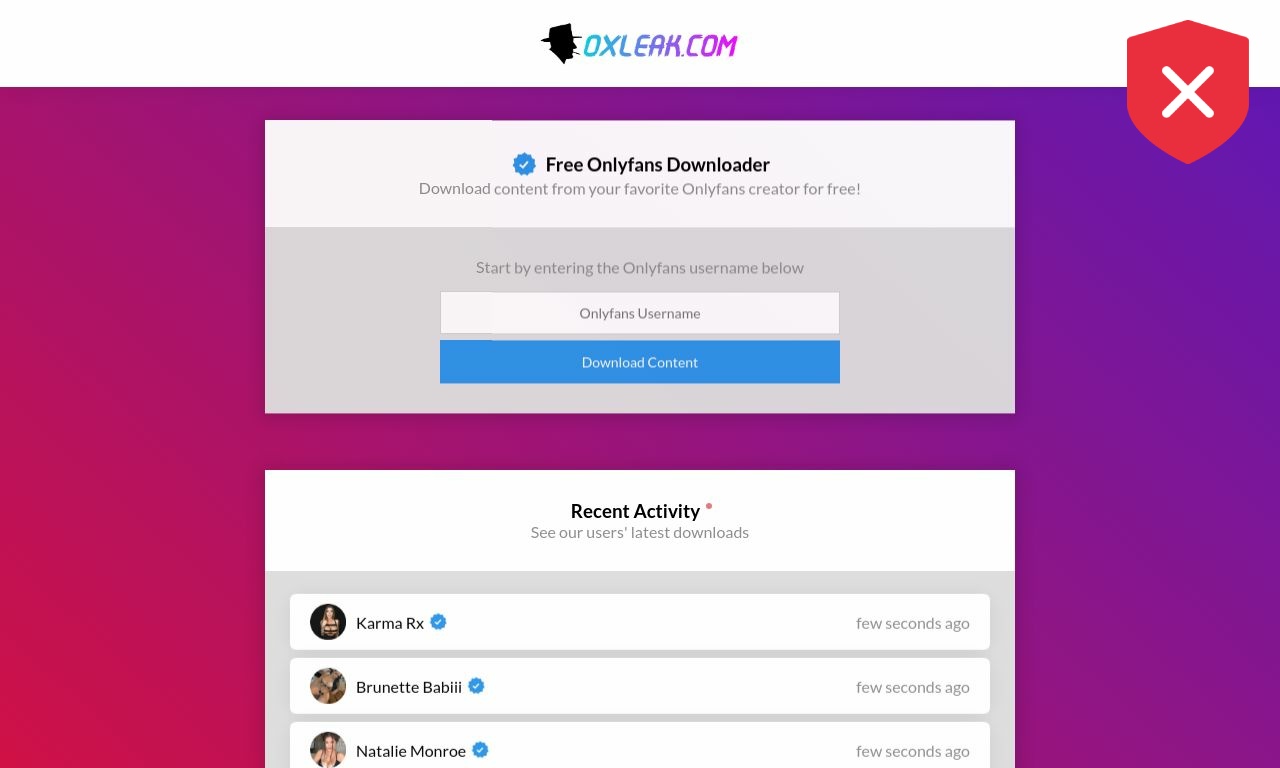Beware: Oxleak.com Is A Scam! Protect Your Info & Money Now
Ever felt that unsettling prickle of doubt when browsing a new website? You should, because in the labyrinthine world of the internet, not everything that glitters is gold, and sites like Oxleak.com serve as stark reminders of the digital dangers lurking in plain sight.
The digital realm, while offering unprecedented access to information and opportunities, has also become a breeding ground for sophisticated scams and deceptive practices. Oxleak.com, a website flagged with a distressingly low trust score, exemplifies this troubling trend. It operates under the guise of legitimacy, enticing unsuspecting users with promises of lucrative investments, irresistible products, and exclusive services. However, beneath the veneer of professionalism lies a carefully constructed facade designed to extract personal information and hard-earned money from its victims. This is achieved through a series of manipulative tactics, including the promotion of fictitious offerings, the use of fabricated testimonials, and the creation of a false sense of security. The website's anonymity, coupled with its lack of a substantial online presence and a disconcerting history of child safety concerns, further exacerbates the risk it poses to internet users.
The red flags surrounding Oxleak.com are numerous and varied, painting a clear picture of a website that should be approached with extreme caution. Its Alexa ranking remains unassessed, indicating a lack of significant traffic and raising questions about its legitimacy. Moreover, the website's social media activity is minimal, suggesting a deliberate attempt to avoid public scrutiny and maintain a low profile. This lack of transparency is further compounded by the website's history of negative reports related to child safety, a deeply concerning issue that should serve as an immediate deterrent to any potential users.
- Filmyfly Your Hub For Bollywood Hollywood More Movies News
- Sd Movies Point Is It Safe Free Movies App More
The core issue is that Oxleak.com engages in activities that are fundamentally deceptive. It presents itself as a legitimate online platform, but in reality, it employs a range of tactics to mislead visitors. These tactics include, but are not limited to, promoting fake products, services, and investment opportunities. The website may also use false claims and testimonials to create a false sense of trust and security. It is crucial to recognize these red flags and exercise extreme caution when interacting with this website.
The alarming truth is that Oxleak.com is not an isolated incident. The internet is rife with similar websites that employ deceptive practices to exploit unsuspecting users. These websites often operate from obscure locations, making it difficult to trace their origins and hold them accountable for their actions. They may also use sophisticated techniques to mask their true identities and evade detection by law enforcement agencies. As a result, it is essential for internet users to remain vigilant and exercise caution when browsing the web.
The ease with which such websites can be created and disseminated underscores the urgent need for greater awareness and preventative measures. Users must be educated about the warning signs of online scams and equipped with the tools to protect themselves from falling victim to these deceptive practices. This includes verifying the legitimacy of websites before sharing personal information, being wary of unrealistic promises and unsolicited offers, and using strong, unique passwords for all online accounts.
- Vegamovies Is It Safe Stream Movies Legally Alternatives
- Bollyflixspa Scam Or Safe Read This Review Before You Watch
Several independent analyses of Oxleak.com have corroborated the concerns raised about its legitimacy. These analyses have highlighted the website's lack of transparency, its use of deceptive tactics, and its potential for engaging in fraudulent activities. The consensus among these analyses is that Oxleak.com poses a significant risk to internet users and should be avoided at all costs.
One of the most troubling aspects of Oxleak.com is its potential impact on vulnerable individuals, particularly children. The website's history of negative reports related to child safety raises serious concerns about its intentions and the potential for it to exploit and harm young people. Parents and guardians must be especially vigilant in monitoring their children's online activity and educating them about the dangers of interacting with unfamiliar websites.
It is also important to remember that even seemingly legitimate websites can be compromised by hackers and used to spread malware or steal personal information. Therefore, it is essential to keep all software and operating systems up to date, install reputable antivirus software, and be cautious about clicking on links or downloading files from untrusted sources.
The responsibility for combating online scams and deceptive practices lies not only with individual users but also with law enforcement agencies, regulatory bodies, and internet service providers. These organizations must work together to identify and shut down fraudulent websites, prosecute perpetrators, and develop effective strategies for preventing future scams.
In conclusion, Oxleak.com serves as a cautionary tale about the dangers of the internet and the importance of exercising caution when browsing the web. By recognizing the red flags of online scams and taking steps to protect themselves, users can minimize their risk of falling victim to these deceptive practices and help create a safer online environment for everyone.
Navigating the digital landscape requires a keen eye and a healthy dose of skepticism. Always question the authenticity of websites, especially those that seem too good to be true. Verify the legitimacy of claims, scrutinize testimonials, and be wary of requests for personal information. By adopting a proactive and informed approach, you can significantly reduce your risk of becoming a victim of online scams and deceptive practices. Remember, in the world of the internet, knowledge is power, and vigilance is key to staying safe.
Beyond the specific case of Oxleak.com, the broader issue of content leaking on the internet raises fundamental questions about privacy, security, and responsibility. The digital age has ushered in an era of unprecedented information sharing, but this accessibility comes at a cost. Personal data, private conversations, and sensitive content can be easily disseminated across the web, often without the knowledge or consent of the individuals involved. This unauthorized disclosure can have devastating consequences, leading to reputational damage, financial losses, and emotional distress.
Combating the unauthorized leakage of content requires a multi-pronged approach that involves individuals, organizations, and policymakers. Individuals must take proactive steps to protect their personal information and control their online presence. This includes using strong passwords, adjusting privacy settings on social media platforms, and being cautious about sharing sensitive information online. Organizations must implement robust security measures to protect their data and prevent breaches. This includes investing in cybersecurity infrastructure, training employees on data security protocols, and establishing clear policies for data handling and storage. Policymakers must enact legislation that protects personal privacy and holds individuals and organizations accountable for data breaches and unauthorized disclosures.
The challenge lies in striking a balance between the free flow of information and the protection of individual privacy. While the internet has democratized access to information and fostered innovation, it has also created new avenues for abuse and exploitation. Finding the right balance requires a thoughtful consideration of the ethical, legal, and social implications of online activity.
The ease with which content can be leaked online is exacerbated by the anonymity that the internet often provides. Individuals can create fake accounts, use proxy servers, and employ other techniques to mask their identities and evade detection. This anonymity can embolden individuals to engage in harmful behavior, such as leaking personal information, spreading false rumors, and engaging in online harassment.
Addressing the issue of online anonymity is a complex and controversial issue. While some argue that anonymity is essential for protecting free speech and enabling whistleblowing, others argue that it facilitates harmful behavior and makes it difficult to hold individuals accountable for their actions. Finding a solution that balances these competing interests requires a careful consideration of the potential benefits and risks of online anonymity.
Ultimately, protecting ourselves from the unauthorized leakage of content requires a combination of individual responsibility, organizational accountability, and effective legal frameworks. By taking proactive steps to protect our personal information, implementing robust security measures, and enacting legislation that protects privacy, we can create a safer and more secure online environment for everyone.
The proliferation of free content-sharing sites presents a unique set of challenges. While these sites can be valuable resources for accessing information and connecting with others, they can also be breeding grounds for the unauthorized leakage of content. Users must be aware of the risks associated with these sites and take steps to protect themselves from harm.
One of the key steps in protecting yourself is to understand the terms of service and privacy policies of the websites you use. These documents outline the rules and guidelines for using the website and explain how your personal information will be collected, used, and shared. By carefully reviewing these documents, you can make informed decisions about whether to use the website and how to protect your privacy.
It is also important to be cautious about the information you share on these websites. Avoid sharing sensitive personal information, such as your address, phone number, or financial details. Be mindful of the photos and videos you upload and be aware of who can access them. Consider using privacy settings to limit the visibility of your content and control who can see your profile.
If you encounter content on a website that you believe violates your privacy or infringes on your copyright, you should report it to the website administrator. Most websites have a reporting mechanism that allows users to flag inappropriate content and request its removal. By reporting these violations, you can help protect yourself and others from harm.
In conclusion, the internet presents both opportunities and challenges. By being aware of the risks and taking proactive steps to protect ourselves, we can harness the power of the internet while minimizing the potential for harm. Vigilance, education, and a commitment to ethical online behavior are essential for navigating the digital landscape safely and responsibly. Remember that oxleak.com is a scam website that tries to trick people into giving away personal information or money, be aware and protect yourself from these kind of scam.
The term "oxleak.com is a scam website that tries to trick people into giving away personal information or money" serves as a crucial keyword term, a stark reminder of the pervasive dangers lurking within the digital realm. It is a warning, a call to vigilance, and a testament to the ongoing battle against online deception. This keyword, in its essence, functions as a noun phrase, a label that encapsulates the essence of a complex and troubling phenomenon. It is a signpost, guiding us to a deeper understanding of the tactics employed by malicious actors and the steps we must take to protect ourselves from their harmful intentions. The implications of this keyword extend far beyond the specific case of Oxleak.com, encompassing the broader landscape of online scams and deceptive practices.
- Prmovies Watch Free Movies Tv Shows Is It Safe Alternatives
- Masahubcomco Legit Traffic Competitors Business Caution

The Ultimate Guide To Oxleak Prevention, Treatment, And More

Oxleak reviews Very Low Trust Score 8

Store oxileak